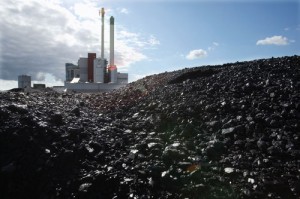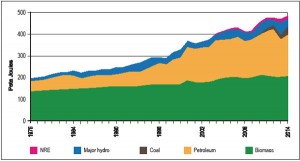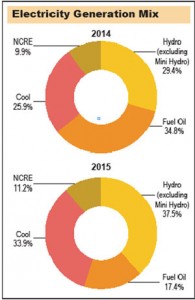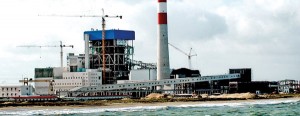Why coal is still cool. Myths and facts!
 There have been many controversies as to whether coal is the right option for Sri Lanka. Everybody says coal is dirty! So why should stick with coal?
There have been many controversies as to whether coal is the right option for Sri Lanka. Everybody says coal is dirty! So why should stick with coal?
There are many media articles about why we don’t want coal and an increasing number of “experts” (environmentalists, politicians, journalists – just about everybody) who are preaching about the evils of coal. Why then does the power related authorities and the Ceylon Electricity Board (CEB) still want to go ahead with coal power – keep the existing coal power plant at Norochcholai and indeed add more like it e.g. Sampur? A legitimate question that needs to be answered and it is high time to do it.
This article aims to analyse the pros and cons of the popular alternatives to coal in the Sri Lankan perspective.
Energy picture of Sri Lanka
If somebody asked you, what is the biggest primary energy source for Sri Lanka, I bet , at least most of us, would say that it’s any of the petroleum fuels (diesel, petrol, LP gas, etc) or coal. But you are wrong!

Evolution of Energy supply forms. Image courtesy: National Energy Balance 2014 - Sustainable Energy Authority Sri Lanka. NRE - stands for New Renewable Energy (Commonly referred to as NCRE - Non Conventional Renewable energy) like wind, solar, small hydro and biomass power plants.
Surprisingly the answer is Biomass. The sum of all the petroleum-based energy supplies (diesel, petro, LP gas and kerosene, etc together) is less than biomass energy.
The high usage of biomass is understandable given its cheap and abundant availability throughout the country which is primarily used for domestic cooking. However because this raw material doesn’t go through the commodity market, biomass is not fully accounted for as a commercially-viable product.
If you closely observe the graph, you can see that the growing need for energy is met by petroleum over the last four decades. It is obvious that if the country does not take necessary precautions we will sink in the “Liquid Petroleum Trap” and it will be too late to get out of it.
While many believe that coal does not play a significant role in our national energy picture, it does in fact play a critical role in our electricity generation.
Demand for electricity grows
With the growing economy and also Sri Lanka aiming to be a country where all the people would have access to power, there is a rapidly growing demand for electricity.

Electricity Generation by Source (reference and image - 2015 Central Bank Report)
GDP and energy demand
One interesting relationship between GDP and electricity demand can be noted in any country as well as in Sri Lanka.
When the economy grows, demand for electricity also grows. In the period 1996-2001 where there were massive power shortages, economic growth fell as evident in the graph above.
It is needless to say that a stable and growing supply of electricity is vital for the economy to grow.
Power generation
Sri Lanka does have a wide energy mix for electricity generation which includes hydro, thermal (coal and oil) as well as non-conventional renewables (NCRE) like solar, wind, small hydro and biomass.
As clearly visible in the graph, one third of the national electricity demand has been met with coal. Compared to 2014 in the last year the dependence on fuel oil for electricity generation has reduced which clearly explains the improved financial figures of CEB.
No coal means more green?
Sampur is on hold at present based on environmental grounds. So why don’t we increase the renewable portion and become a 100 per cent renewable energy sustainable nation? Is it only the economics that’s holding us back?
The government after cancelling the coal power project in Sampur is not considering renewable alternatives to fill up the gap as opposing environmentalists expected. The government has already called tenders for a 300MW natural gas power plant which will run with diesel initially (at least for the next five to 10 years). This is not the first project of its kind as the 300MW power plant in Kerawalapitiya is running with diesel (which is primarily built to run with natural gas) for the last eight years at a cost of Rs. 45.75 per unit. This is six times higher than the cost of a unit generated in Norochcholai which is Rs. 7.63 (Source – PUCSL 2015 First Half Generation Report).
Renewables SL scenario
The CEB as well as the private sector is investing in renewable power. As a result, the renewable power capacity has been growing annually during the last decade.
But we are not planning to wean off our dependency on coal/diesel anytime soon. Coal is dirty but it is cheap. Diesel is also dirty and really expensive but it’s a quick solution for the power crisis. Diesel as a quick and easy solution (without environmentalists protesting) is the reason why Sri Lanka is planning a 300MW diesel power plant (with the LNG board name on it).
Most of the rich/developed countries have used coal as an energy source to get to the point where they are today. That is why despite of all the controversy, 44 per cent of the German electricity generation still comes from coal – a country which is taken as a role model for renewables. Our neighbouring country India has a total of 185,173 MW of coal power plants installed as of 2016. We Sri Lanka have 900 MW only and another 500 MW is yet to come in Sampur – presently on hold based on environmental ground. The following cost indicators justify the preference to coal in terms of rupees and cents as per the 2015 Central Bank report.

Average Cost of Generation in 2015 (Source - 2015 Central Bank Report)
It is clear that adding more renewables and diesel power comes with a huge burden for the national economy which is currently having a budget deficit of 7.4 per cent.
Logic beyond economics
Is there anything more apart from the cost aspect? Are only the economic factors holding us back from going for more renewables? Let’s find out. Everybody knows renewables are environmental friendly and have a comparatively low operating cost if we absorb the initial high capital investment. So why don’t we scale up renewable energy production and leave out coal altogether? It turns out that there is a fundamental flaw that goes with renewable sources.
Just like any natural thing the renewables work at nature’s pace. They are not available to us when we want at the rate we need. But our demand for electricity stays almost constant throughout the year. Let’s dig deeper into the two most popular renewable sources – solar and wind.
Why not 100 per cent solar to match the gap? If we take the daily profile of the power demand in Sri Lanka, the peak electricity demand occurs at night in the time slot 6.30pm – 9.30pm with a peak at 7.30pm.
While it is clear that no solar generation is possible during this time slot, Sri Lankans still need power during that time as we are at home with our families. So isn’t there a solution? There are advanced technologies like battery storage, pumped-storage, etc to mitigate this limitation but being a Third World country the economics do not work in favour of this option.
 Why not wind only?
Why not wind only?
Wind is a highly seasonal and an unpredictable energy source. Therefore it’s not a viable option as the main power source to cater to the base demand except for plugging marginal gaps in the supply. We Sri Lankans do not want power cuts when there is no wind blowing, right?
Other renewable options
It is a known fact that hydro varies drastically over the year, with fluctuations in rainfall. We have had good experience of this variability during the last couple of years.
Hydro power projects also cause considerable damage to entire ecosystems. There are dendro (biomass) power plants available in Sri Lanka but the output varies seasonally due to biomass supply variations.
Apart from the solar, wind and small hydro options, the CEB is considering Natural Gas (LNG – Liquefied Natural Gas) as one option in their 2015 – 2034 generation plan. But one thing to note is that natural gas is not a renewable option (it is also a form of a fossil fuel) although the environmental impact is lesser compared to coal. However again economic factors also have to be considered with the complex fuel storing and transportation methodologies involved with LNG with respect to the Sri Lankan perspective.
(The writer is an Electrical Engineer by profession and a sustainability enthusiast. He holds a Masters degree in Energy Systems from University of Gavle, Sweden and B.Sc (Eng) Hons from University of Moratuwa, Sri Lanka specialising in Electrical Engineering, and currently he serves as the Senior Electrical Engineer – Power System Design at M.A. Consultants in Qatar. He could be reached at nadeerawije@gmail.com).


